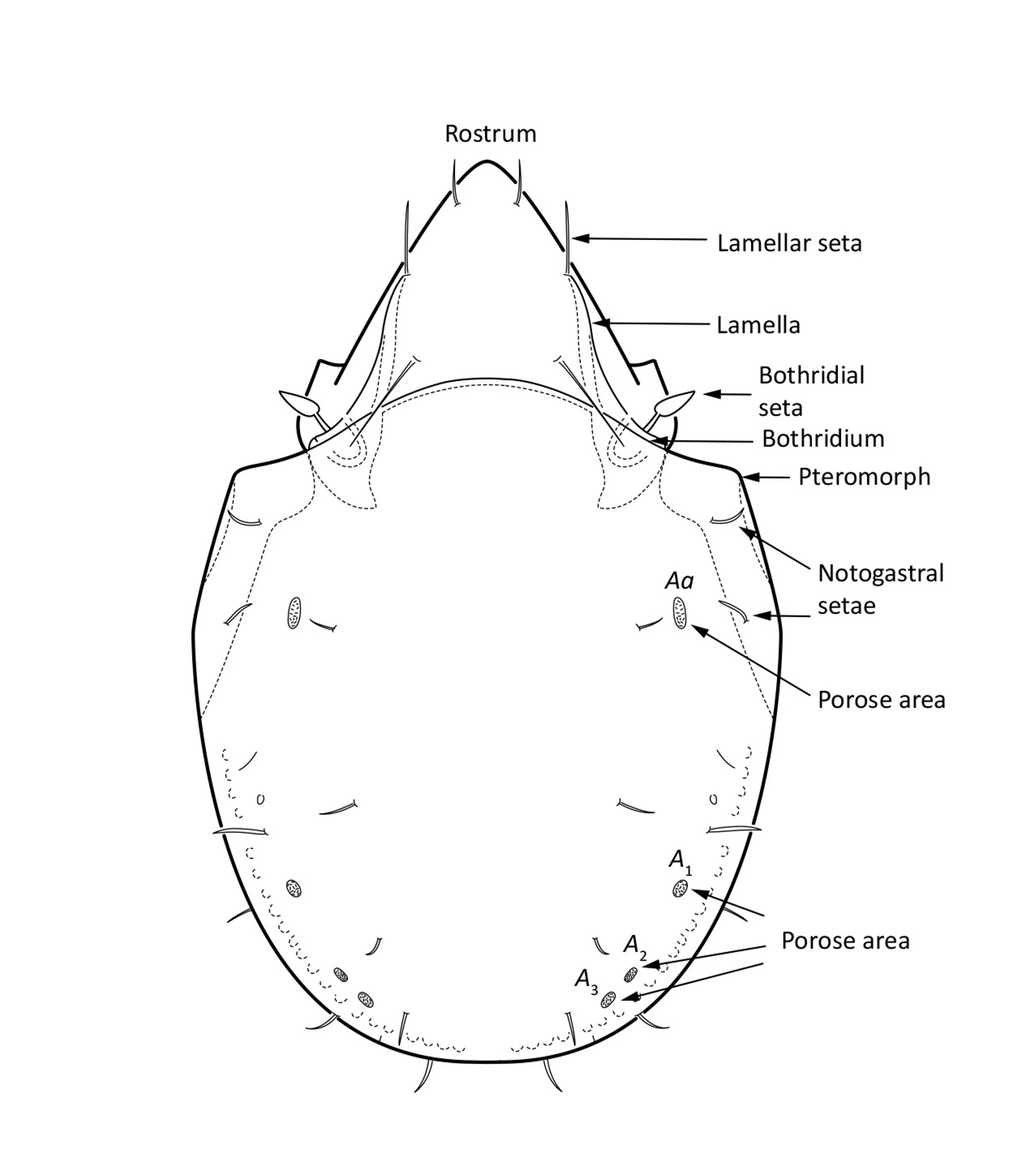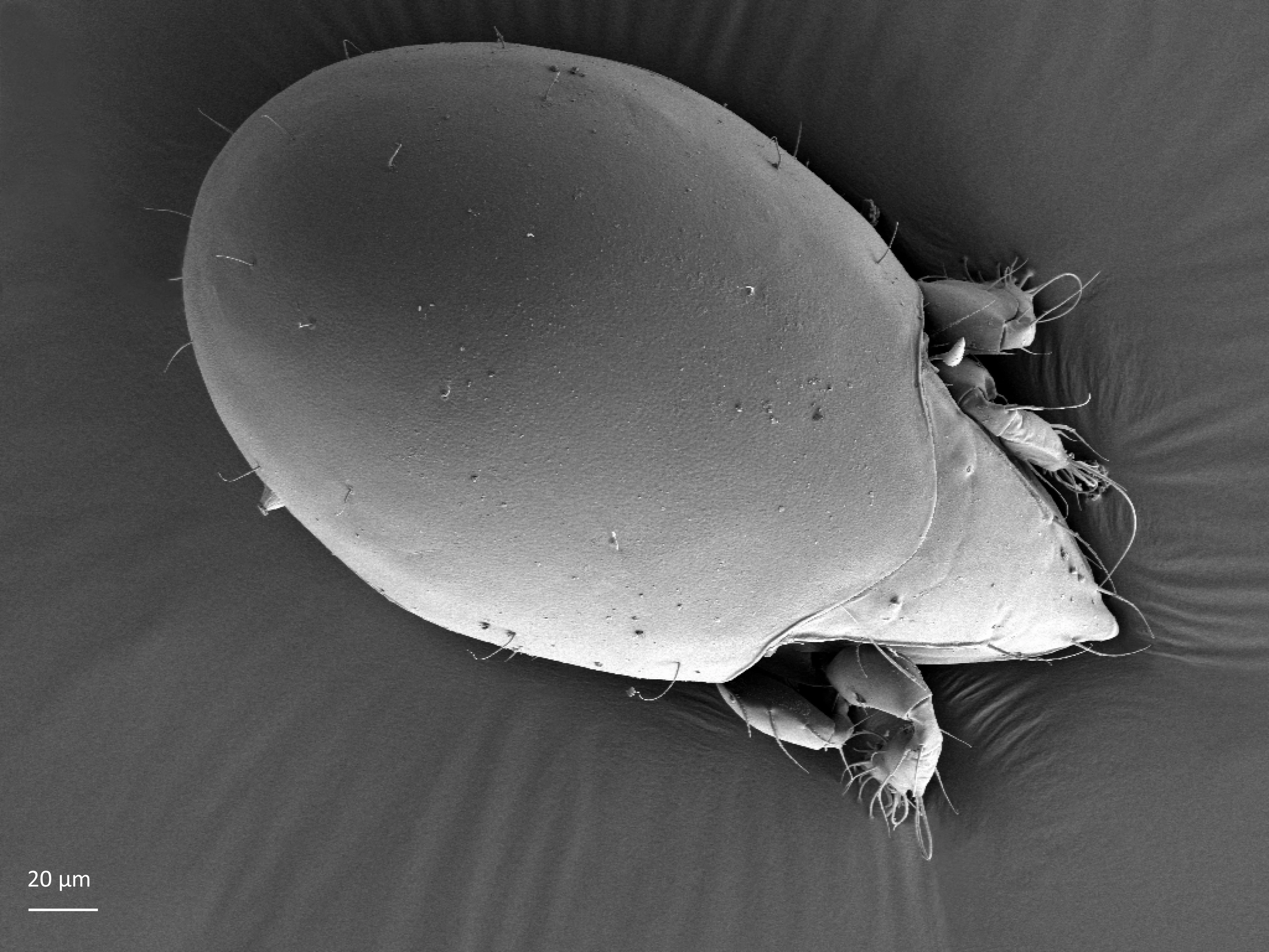Lagenobates lagenulus
The species is distributed across the Palearctic and Canada. It is characteristic of raised bogs, and is also found in pastures. It is an intermediate host of Moniezia tapeworms that are parasitic in mammals, including sheep, goat and cattle. Lagenobates lagenulus was first found in Norway in 2019, in a broadleaf forest, but very few individuals were found.
Description

Fig. 1. Dorsal view of Lagenobates lagenulus, adult.

Fig. 2. Dorsal view of Liebstadia similis, adult.
Adult: The body length is 270–330 µm, and width is 185 µm. The color is pale brown, and the cuticle is smooth. The lamellae extend from the upper side of bothridium (Fig. 1), and sublamella are well-developed (not seen in dorsal aspect in Fig 1). The bothridial seta has a short S-shaped, curved stem and a thick, spindle-shaped head. Notogaster is with 3–4 pairs of porose areas (named Aa, A1, A2 and A3), since porose areas A2 and A3 are often fused. The notogastral setae are short (15–20 µm). The pteromorphs (wing-like structures) are fully developed and immovable. Each leg has one claw.
Juvenile stages: unknown.
Look-alikes
Among Oribatida known from Norway it is most similar to a common species, Liebstadia similis (Michael, 1888), but is almost half of the size of Liebstadia similis (Liebstadia similis is 500–600 µm long). Lagenobates lagenulus has short bothridial seta with a thick spindle-shaped head, while Liebstadia similis has a long bothridial seta with a spindle-shaped head (Fig. 2). Lagenobates lagenulus has fine, short rostral setae and lamellar setae do not reach the rostrum, while Liebstadia similis has these setae stronger and longer and they extend beyond the rostrum.
Biology
Lagenobates lagenulus has sexual reproduction. Its development and feeding preferences are unknown.
Ecology
This species is an intermediate host of Moniezia tapeworms that are parasitic in mammals, including sheep, goat and cattle.
Distribution
The species is distributed across the Palearctic, but less frequent in the north, and Canada.
Habitat
It is characteristic of acidic raised bogs, and is also found in pastures
Findings in Norway
Lagenobates lagenulus was first found in Norway in 2019. It has been found in a low-herb broadleaf forest in Kvam, Western Norway. Among over 6300 oribatid mite specimens examined only two adult specimens of L. lagenulus were found in mosses growing on ground and on tree stumps.
References
Balogh J, Kassai T and Mahunka S (1965). Studies on tapeworms in ruminants. I. The oribatid fauna of pastures in Hungary. Acta Veterinaria 15(2), 213–225.
Seniczak A, Bolger T, Roth S, Seniczak S, Djursvoll P and Jordal BH (2019). Diverse mite communities (Acari: Oribatida, Mesostigmata) from a broadleaf forest in western Norway. Annales Zoologici Fennici 56(1), 121–136. doi.org/10.5735/086.056.0111
Subías LS (2004). Listado sistemático, sinonímico y biogeográfico de los ácaros oribátidos (Acariformes, Oribatida) del mundo (excepto fósiles). Graellsia 60 (número extraordinario), 3–305.
Weigmann G and Miko L (2002). Redescription of Oribates lagenula Berlese, 1904, the type of Lagenobates n. gen. (Acarina Oribatida). Redia 85, 29–35.
Weigmann G (2006). Hornmilben (Oribatida). Die Tierwelt Deutschlands. 520 pp. Vol. 76, Goecke and Evers, Keltern.
Siden siteres som:
Seniczak A (2020). Lagenobates lagenulus (Berlese, 1904). www.artsdatabanken.no/Pages/286340. Nedlastet <dag/måned/år>
